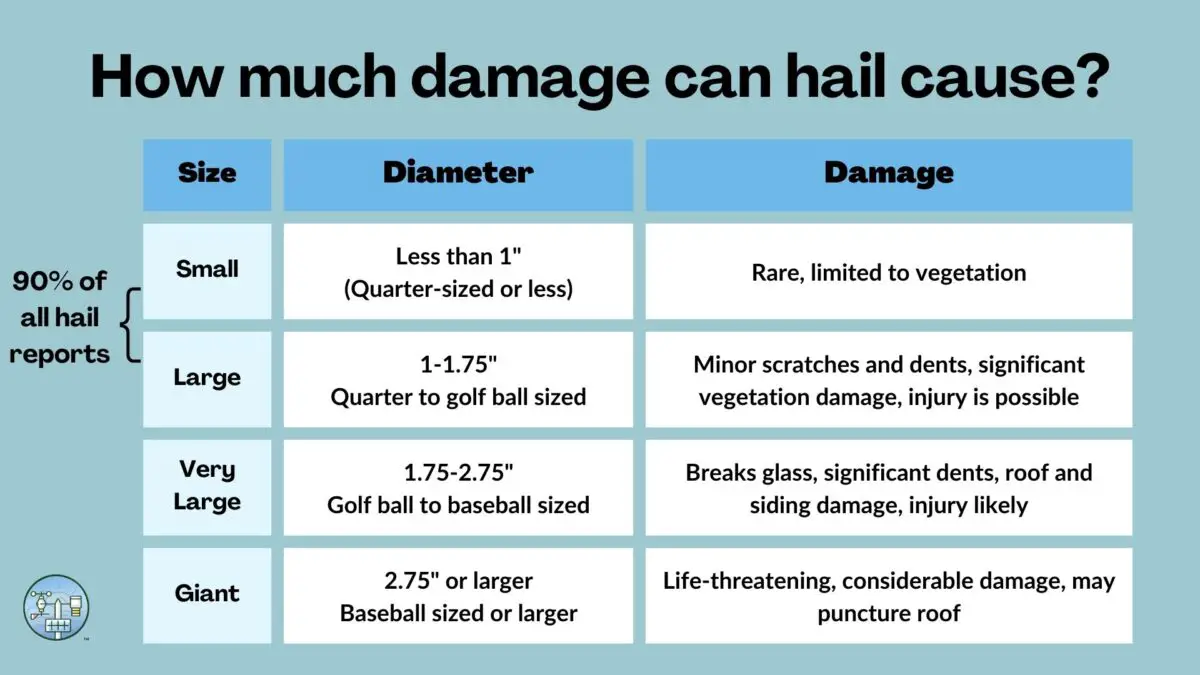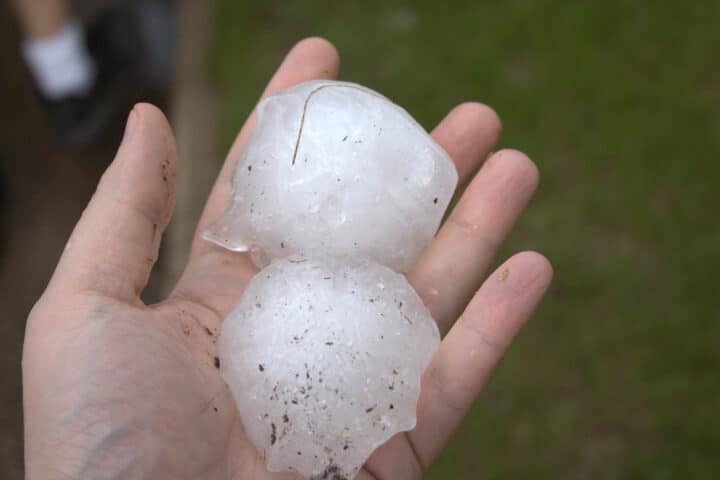When the temperatures are warm, the last thing you’re thinking about is frozen precipitation falling from the sky. But it happens, and it’s called hail. Hail is a fascinating weather phenomenon. This blog post explores how hail forms and what you should do if you find yourself in the middle of a hail storm.
What is hail?
Hail is a form of precipitation that consists of frozen water droplets. It typically occurs during thunderstorms and is most commonly seen in the springtime, although hail can happen at any time of year.
Hail develops when an updraft lifts water droplets high inside a thunderstorm cloud where it is much colder. As these droplets cool, they turn into ice crystals. Hailstones vary in size, but they generally are less than 3/4″ or “quarter-sized.”
These crystals then clump together and grow larger as updrafts and downdrafts push the hail storm up and down through the thunderstorm. Once the hailstones become too heavy to be carried by the updraft, they fall to the ground. When hailstone falls to the ground, it can cause damage to crops, vehicles, and homes — even quarter-sized hail can cause some limited damage. In rare cases, hailstones can become large enough to become deadly — although hail that’s 1″ or larger can cause injury.

What was the size of the largest hailstone?
On July 23, 2010, a hailstorm swept across the town of Vivian, South Dakota, dumping a record-breaking amount of hail on the community. The largest hailstone recovered from the storm was an impressive 8 inches in diameter and weighed nearly 2 pounds. At this size, hailstones fall at speeds of 100 mph, more than enough force to puncture holes in roofs!

Can hail accumulate?
Yes! In severe hailstorms, it is not uncommon for hail to accumulate several inches, enough that road crews must plow it off the roads. The record for most hail accumulation is 18″ in Seldon, Kansas, in 1959. That’s the same depth as many major snowstorms!

What are the dangers of hail?
While hail is generally small, it can cause property damage and injury. It’s estimated that $15 billion in hail damage to property and crops occurs each year in the US.
As we mentioned earlier, hailstones have been known to reach sizes as large as eight inches in diameter and can fall at up to 100 miles per hour. When hailstones hit unprotected skin, they can cause bruising and cuts and in rare cases, death. In addition, hailstorms can result in power outages and disruptions to transportation.

What to do if you find yourself in the middle of a hail storm
Anyone caught in a hail storm can attest that it can be terrifying and dangerous. Hail can cause serious injuries, and the high winds can make it challenging to stay on your feet.
If you find yourself in the middle of a hail storm, the best thing to do is take cover. Find a sturdy building or car to shelter under, and stay away from windows. If there is no shelter available, lie flat on the ground and protect your head with your arms. In addition, try to stay away from open fields, trees, and power lines, as these can all be hazards during a hail storm.
What to do after a hail storm
After a hail storm, the first thing you should do is survey the damage. Look for any broken windows or damaged siding. If your roof is damaged, tarp areas of damage as soon as possible to prevent further issues. Take as many pictures as possible of damage; you will need these for the insurance claim.
It’s also critical to find a contractor as soon as possible. In widespread hailstorms, local contractors will book up quickly, and it may be days or weeks before they can get to you. Contact your home insurance provider to discuss coverage and set up a claim. Again, doing this early is critical to prevent delays in repairs.

Once you’ve assessed the damage, you can start cleaning up. Remove any debris from your yard, and if there are leaves or branches on your roof, be sure to remove them. If hail has damaged your gutters, they will need to be replaced.
Finally, once everything is cleaned up, you can start making repairs. While this is a several-week (if not several months) process, setting up the claim and repairs right away will simplify the process.



